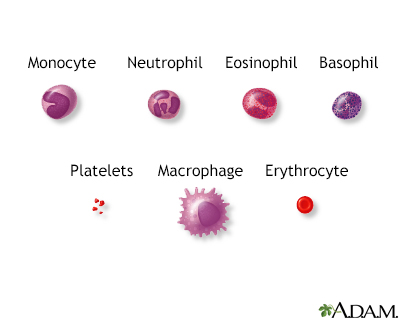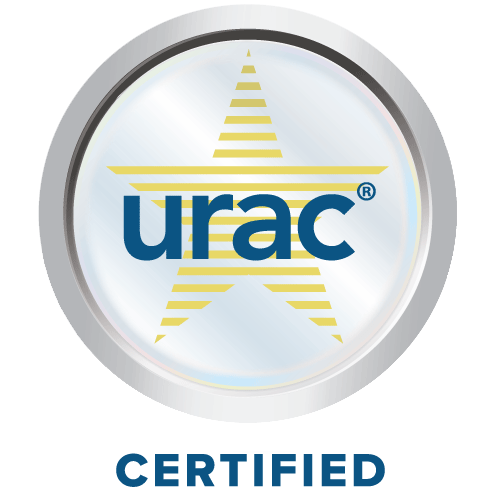Essential thrombocythemia
Primary thrombocythemia; Essential thrombocytosis
Essential thrombocythemia (ET) is a condition in which the bone marrow produces too many platelets. Platelets are particles in the blood that aid in blood clotting.
Images

Animation

Causes
ET results in an overproduction of platelets. The higher number of platelets may increase the risk of clotting. However, bleeding may occur with very high platelet count because blood clots use up the body's platelets. Untreated, ET worsens over time.
ET is part of a group of conditions known as myeloproliferative disorders. Others include:
- Chronic myelogenous leukemia (an overproduction of white blood cells that starts in the bone marrow)
- Polycythemia vera (bone marrow disease that leads to an abnormal increase in the number of red blood cells)
- Primary myelofibrosis (disorder of the bone marrow in which the marrow is replaced by fibrous scar tissue)
Many people with ET have a variation of a gene (JAK2, CALR, or MPL).
ET is most common in middle- to older-age people. It can also sometimes be seen in younger people, especially women.
Symptoms
Symptoms may include any of the following:
- Headache
- Tingling, coldness, or blueness in the hands and feet
- Feeling dizzy or lightheaded
- Vision problems
- Mini-strokes (transient ischemic attacks) or stroke
If bleeding is a problem, symptoms may include any of the following:
- Easy bruising and nosebleeds
- Bleeding from the gastrointestinal tract, respiratory system, urinary tract, or skin
- Bleeding from the gums
- Prolonged bleeding from surgical procedures or tooth removal
Exams and Tests
Most of the time, ET is found through blood tests done for other health problems before symptoms appear.
Other tests may include:
- Bone marrow biopsy
- Complete blood count (CBC)
- Genetic tests (to look for a change in the JAK2, CALR, or MPL gene)
Treatment
If you have life-threatening complications, you may have a treatment called platelet pheresis. It quickly reduces the number of platelets in the blood.
Long-term, medicines are used to decrease the platelet count to avoid complications. The most common medicines used include hydroxyurea, interferon-alpha, or anagrelide.
Aspirin at a low dose (81 to 100 mg once or twice per day) may decrease clotting episodes.
Many people do not need any treatment, but they must be followed closely by their health care provider.
Outlook (Prognosis)
Outcomes may vary. Most people can go for long periods without complications and have a normal lifespan. In a small number of people, complications from bleeding and blood clots can cause serious problems.
In rare cases, the disease can change into acute leukemia or myelofibrosis.
Possible Complications
Complications may include:
- Acute leukemia or myelofibrosis
- Severe bleeding (hemorrhage)
- Stroke, heart attack, or blood clots
When to Contact a Medical Professional
Contact your provider if:
- You have unexplained bleeding that continues longer than it should.
- You notice chest pain, leg pain, confusion, weakness, numbness, or other new symptoms.
Related Information
Platelet countPolycythemia vera
Chronic myelogenous leukemia (CML)
Myelofibrosis
Respiratory
Blood clots
Incidence
Stroke
Causes
Heart attack
Heart attack - test
References
Gotlib J. Polycythemia vera, essential thrombocythemia, and primary myelofibrosis. In: Goldman L, Cooney KA, eds. Goldman-Cecil Medicine. 27th ed. Philadelphia, PA: Elsevier; 2024:chap 152.
Marcellino BK, Mascarenhas J, Iancu-Rubin C, Kremyanskaya M, Najfeld V, Hoffman R. Essential thrombocythemia. In: Hoffman R, Benz EJ, Silberstein LE, et al, eds. Hematology: Basic Principles and Practice. 8th ed. Philadelphia, PA: Elsevier; 2023:chap 71.
National Cancer Institute website. Myeloproliferative neoplasms treatment (PDQ) -- health professional version. www.cancer.gov/types/myeloproliferative/hp/myeloproliferative-neoplasms-treatment. Updated September 27, 2024. Accessed February 11, 2025.
BACK TO TOPReview Date: 2/3/2025
Reviewed By: Warren Brenner, MD, Oncologist, Lynn Cancer Institute, Boca Raton, FL. Review provided by VeriMed Healthcare Network. Also reviewed by David C. Dugdale, MD, Medical Director, Brenda Conaway, Editorial Director, and the A.D.A.M. Editorial team.

Health Content Provider
06/01/2028
|
A.D.A.M., Inc. is certified by URAC, for Health Content Provider (www.urac.org). URAC's certification program is an independent audit to verify that A.D.A.M. follows rigorous standards of quality and accountability. A.D.A.M. is among the first to achieve this important distinction for online health information and services. Learn more about A.D.A.M.'s editorial policy, editorial process and privacy policy. |
The information provided herein should not be used during any medical emergency or for the diagnosis or treatment of any medical condition. A licensed medical professional should be consulted for diagnosis and treatment of any and all medical conditions. Links to other sites are provided for information only -- they do not constitute endorsements of those other sites. © 1997- 2025 A.D.A.M., a business unit of Ebix, Inc. Any duplication or distribution of the information contained herein is strictly prohibited.
